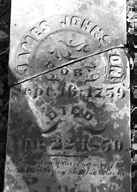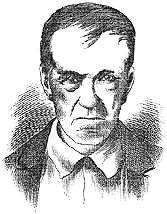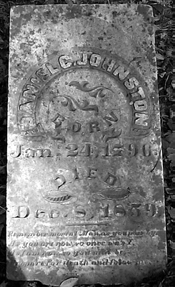The Bell Witch: The Full Account (43 page)

invalid for the remainder of his life. Reverend
Thomas Gunn died in May of 1859 at the advanced
age of 89 years, and is buried in one of the two Gunn
cemeteries near Adams, Tennessee. 77
76
McFerrin’s History of Methodism in Tennessee
, 1886.
77 Information about the Gunns was obtained from the Bible of Reverend James Gunn
and information provided to the author by Nancy Williams Lewis, a direct descendant of the Gunns.
THE BELL WITCH: THE FULL ACCOUNT
319
James Johnston (1759-1851)
No man or family was closer to John Bell’s family
during the disturbances than James Johnston and
his two sons, John and Calvin. James Johnston was
the first person outside the Bell family whom John
Bell confided in about Kate’s disturbances. Johnston
and his wife were the first people outside the Bell
family known to have had an encounter with Kate.
The first question that Johnston asked Kate, “In
the name of the Lord, who and what are you, and
what do you want?” would turn out to be the most
popular question asked of Kate throughout the
period of the disturbances. Johnston first thought
the disturbances were a practical joke being played
by the Bell children or others in the community;
however, he changed his mind after spending several
nights at the Bell home. He learned that the entity
causing the disturbances possessed an intelligence
all its own.
James Johnston was a very devout Christian.
Despite his inability to read or write, he was
considered by many to be an expert on Christianity
and the Bible. Because the Bible says that both good
and bad Spirits exist, and that trafficking with the
evil supernatural is possible, Johnston often
expressed his strong belief that the disturbances
were being caused by “An evil Spirit, a demon, just
like in the Bible!” His sons, John and Calvin, also
shared this belief.
The Johnstons had the most commonly misspelled
surname in the entire “Bell Witch” legend, “Johnson.”
The correct spelling is “Johnston,” with the Scottish
pronunciation silencing the “t.” The first Johnstons
to settle in America came from Annandale, Scotland
by way of County Tyrone in Northern Ireland, settling
320 P A T
F I T Z H U G H
in Pennsylvania before moving southward to Virginia
and the Carolinas as land grants became available.
Born in Pennsylvania in 1759, James Johnston was
the youngest child of John and Mary Patterson
Johnston.
After spending his early childhood in
Pennsylvania, he moved to Caswell County, North
Carolina with his parents and siblings. After
reaching a suitable age, Johnston joined the North
Carolina Continental Line and fought in the
Revolutionary War. He married Rebecca Porter in
July of 1780, and they had nine children before her
death in 1802. In 1800, James Johnston and his
family migrated to Robertson County, Tennessee as
his brother did twenty years earlier.
Because of the treacherous terrain and Native
American conflicts in the Cumberland Gap and
Tennessee River areas at the time, Johnston brought
his family and belongings to Tennessee by way of
Georgia. In addition to his concerns about providing
a safe and smooth passage for his family, Johnston
was also concerned about protecting a priceless
china cabinet that he had decided to carry on the
journey. Because of James Johnston’s awareness of
the possible dangers along the way and his efforts to
avert them, a very old and priceless china cabinet
sits today in the dining room of a private residence
near Adams, Tennessee.
Johnston and his family settled on 1,000 acres of
land that he received as a grant for serving in the
Continental Army. The Johnston farm was situated
along the Red River just east of present-day Adams,
Tennessee and encompassed both sides of Sturgeon
Creek. About two years after the death of his first
wife, Johnston married Jane Marvlin Greer. Having
no children of their own, they adopted Jane’s niece,
Parthenia “Theny” Thorn, of Stewart County,


THE BELL WITCH: THE FULL ACCOUNT
321
Tennessee. Born on Christmas of 1804, “Theny”
Thorn lost her parents at an early age and had been
placed in the care of her aunt, Jane Greer. 78 She
always referred to James and Jane Johnston as her
parents.
James and Jane Johnston
subscribed to the doctrine of the
Cumberland Presbyterian Church.
Because there was no
Cumberland Presbyterian Church
in the area, they joined the
Methodist Church because they
felt part of their Christian duty
was to be active members of some
church. James Johnston died in
April of 1850 at the advanced age
of 91 years, and is buried along with his two wives
and many relatives near Adams, Tennessee. 79
John Johnston (1783-1874)
Like his father, John Johnston often sat up nights
and talked to Kate so the Bells could sleep. Despite
her insistence that his motives were less than
sincere, Kate frequently
engaged John Johnston in
fascinating and thought-
provoking conversation.
During one discussion, he
asked Kate what his Dutch
step-grandmother in North
Carolina said when one of
her slaves did something
wrong. Using the woman’s
own voice and Dutch accent,
78 Theny Thorn’s birth date obtained from her gravestone.
79 Correspondence with Mr. Jim Brooks, a direct descendant of the Johnston family.
322 P A T
F I T Z H U G H
Kate replied, “Hut, tut.
What
has happened now?”
“Hut tut” is a Dutch term meaning “No-no,” and is
used as a chiding expression — almost a term of
endearment. Johnston later told others about this
astonishing encounter, describing how quickly Kate
returned the correct phrase and how perfectly she
imitated his step-grandmother.
On another occasion, Kate allowed John
Johnston’s brother, Calvin, to shake her hand. After
learning of this incident, Johnston repeatedly begged
Kate for the opportunity to shake her hand. She
continually refused, stating that he was only “out to
get her” and that his brother’s intentions had been
sincere. 80
One of the most significant things that John
Johnston learned about Kate was that she could not
fully read minds, as some people believed. He asked
her on several occasions what he was thinking. He
said that while her guesses were sometimes close,
she never gave the right answer.
During one of their discussions, Kate became
angry with Johnston and threatened to kill him. On
his way home the following morning, he noticed what
looked like the shadow of a long, sharp knife behind
him. He thought to himself, “If the Lord wants me to
die, then I will die; I will not run.”
He stood still in his tracks to see what fate would
deal him. The “knife” never disappeared, and after
taking the time to analyze his surroundings, he
realized that the “knife” was actually the shadow of a
blade from a corn stalk, blowing in the wind. After
this incident, Johnston hypothesized that many so-
called “encounters” with Kate were logical things
such as the shadow of the corn blade, but that most
80 John Johnston’s photo from
Authenticated History of the Bell Witch
, M.V. Ingram, 1894.
THE BELL WITCH: THE FULL ACCOUNT
323
people ran away without taking the time to observe
their surroundings and determine the true cause.
John Johnston was born and spent his
childhood
in North Carolina before moving to Robertson
County, Tennessee in 1800 with the rest of his
family. In 1810, he married Martha Johnston, his
first cousin and the daughter of James Johnston’s
brother, William, who moved to the area about 1780.
John and Martha Johnston had eight children, one
of whom was Nancy Johnston, the baby who was
spanked by Kate. Like John Bell’s eldest sons, John
Johnston was a member of the Tennessee Militia and
fought in the battles of Horseshoe Bend and New
Orleans. John Johnston died in March of 1874 and
is buried along with his relatives near Adams,
Tennessee. 81
Calvin Johnston (1796-1859)
Daniel Calvin Johnston was the man who Kate
allowed to shake her hand. He often spoke of the
incident, describing Kate’s hands as being “fragile
and velvety.” Kate thought a great deal of Calvin
Johnston, often using him as a basis for comparison
when telling others of their faults, exclaiming, “There
is no finer man in this country than Calvin
Johnston.”
Born in North Carolina, Calvin Johnston was a
toddler when his family moved to Tennessee in 1800.
He spent his childhood on the Johnston farm in
Robertson County, Tennessee, where he developed a
keen interest in Latin and horticulture. He married
Francis Porter, a first cousin, in 1823 and had one
child.
He built a large brick home on his father’s farm
81 Correspondence with Mr. Jim Brooks, a direct descendant of the Johnston family.

324 P A T
F I T Z H U G H
and spent most of his adult life there. It is believed
that the house was built around 1841, with that
being the date carved into a stone window lintel. In
1850, four years after the death of his first wife,
Johnston married Elizabeth Holland. They had no
children of their own.
Contrary to the way in which Calvin Johnston is
portrayed by many authors and historians, he was in
fact a very enlightened and innovative man, much
more so than many of his peers.
One of his greatest achievements was his creation
of a raised writing system for the blind, which
enabled them to read written materials with their
fingers. After perfecting his system, Johnston
traveled to New Orleans to apply for a patent. Upon
his arrival, he learned that a Frenchman named
“Braille” had received a patent for the same type of
writing system only a week earlier.
A horticulture enthusiast, Johnston collected